This is a complete list of the reptiles of Bulgaria. Bulgaria is inhabited by 37 reptilian species, which makes the reptiles the second least diverse class of vertebrates in the country, after the amphibians.[1] The list includes four species that have not been recorded in the country since the first half of the 20th century — the loggerhead sea turtle, green sea turtle, aspic viper and meadow viper. There are six turtle and tortoise species of four families — Cheloniidae, Emydidae, Geoemydidae and Testudinidae; 13 lizard species of four families — Anguidae, Gekkonidae, Lacertidae and Scincidae; and 18 snake species of four families — Boidae, Colubridae, Typhlopidae and Viperidae.
Order Testudines
Family Cheloniidae
Cheloniidae is a family of sea turtles with worldwide distribution in all tropical oceans. The family contains seven species in five genera, of which two species have been recorded in the waters off the Bulgarian Black Sea Coast.[2]
Family Emydidae
Emydidae, also known as pond or march turtles, are a family of fresh water turtles. With the exception of two species, they are distributed in the Western Hemisphere. There are close to 50 species in 10 genera, of which one species occurs in Bulgaria.[7]
Emydidae
| Species |
Common name |
Distribution |
Status |
Image |
| Emys orbicularis |
European pond turtle |
The species is found in the rivers and lakes all over the country. It has been recorded up to 1100 m altitude in Lozen Mountain.[8] |
NT [9] |
 |
|
Family Geoemydidae
Geoemydidae are one of the largest and most diverse turtle families. They are distributed in North America, northern South America, Europe, northwestern Africa and Asia. The family contains about 70 species in 19 genera, of which one species occurs in Bulgaria.[10]
Family Testudinidae
Testudinidae, also known as tortoises, are a family of land-dwelling turtles found in North and South America, Europe, Africa and Asia. They are terrestrial and inhabit warm areas ranging from rain forests to deserts. The family contains about 50 species in 11 genera, of which 2 species are found in Bulgaria.[13]
Suborder Lacertilia
Family Anguidae
Anguidae are a family of legless lizards distributed in the Northern Hemisphere. The group includes both egg-laying and viviparous species. There are 73 species in 10 genera, of which two species occur in Bulgaria.[18][19]
Anguidae
| Species |
Common name |
Distribution |
Status |
Image |
| Anguis fragilis |
slow worm |
The species is found in most regions of the country.[20] |
NE [21] |
 |
| Pseudopus apodus |
European legless lizard |
The species is found in the lowlands of south-eastern Bulgaria and along the Black Sea coast, with isolated populations in the lower valleys of the rivers Rusenski Lom and Struma.[22] |
NE [23] |
 |
|
Gekkonidae are a large family of small to mid-size gackos. They have global distribution with particular diversity in tropical areas. Gekkonidae include 1033 species in 51 genera, of which one species is found in Bulgaria.[24]
Gekkonidae
| Species |
Common name |
Distribution |
Status |
Image |
| Cyrtopodion kotschyi |
Kotschy's gecko |
The species is found in south-eastern Bulgaria, including the Upper Thracian Plain and the Eastern Rhodope Mountains, as well as along the Black Sea coast and the lower Struma valley.[25] |
LC [26] |
 |
|
Lacertidae
| Species |
Common name |
Distribution |
Status |
Image |
| Darevskia praticola |
meadow lizard |
The species is found in most of the country, except for the south-western regions and the Upper Thracian valley.[27] |
NT [28] |
 |
| Lacerta agilis |
sand lizard |
The species is found in Rila, Pirin, western Rhodope Mountains, western and central Balkan Mountains, Sredna Gora and Osogovo, as well as isolated populations in Strandzha and the northern Black Sea coast.[29] |
LC [30] |
 |
| Lacerta trilineata |
Balkan green lizard |
Most common in the lowlands of eastern Bulgaria, as well as in the lower Struma valley.[31] |
LC [32] |
 |
| Lacerta viridis |
European green lizard |
The species is common throughout the country, except for the highest mountains.[33] |
LC [34] |
.JPG) |
| Ophisops elegans |
snake-eyed lizard |
The species inhabits only a small area in the eastern Rhodope Mountains and the lower valley of the Maritsa river.[35] |
NE [36] |
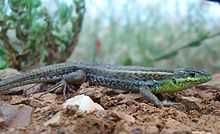 |
| Podarcis erhardii |
Erhard's wall lizard |
The species occurs in south-western Bulgaria and the eastern Rhodope Mountains.[37] |
LC [38] |
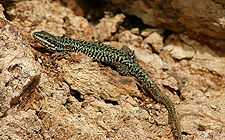 |
| Podarcis muralis |
common wall lizard |
The species is widespread in the whole country.[39] |
LC [40] |
 |
| Podarcis tauricus |
Balkan wall lizard |
The species is found in the lowlands of northern and eastern Bulgaria, as well as in the lower Struma valley.[41] |
LC [42] |
 |
| Zootoca vivipara |
viviparous lizard |
The species is found in in Rila, Pirin, Vitosha, the western Rhodope Mountains, the western and central Balkan Mountains and Osogovo.[43] |
LC [44] |
 |
|
Family Scincidae
Scincidae
| Species |
Common name |
Distribution |
Status |
Image |
| Ablepharus kitaibelii |
European copper skink |
The species is found in the whole country, except for some areas to the south-west.[45] |
LC [46] |
 |
|
Suborder Serpentes
Boidae
| Species |
Common name |
Distribution |
Status |
Image |
| Eryx jaculus |
javelin sand boa |
The species is found in south-eastern Bulgaria, as well as in isolated populations in the lower Struma valley and around Svishtov along the Danube river bank.[47] |
NE [48] |
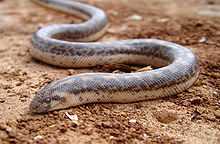 |
|
Colubridae
| Species |
Common name |
Distribution |
Status |
Image |
| Coronella austriaca |
smooth snake |
The species is found in the whole country, up to 1600 m altitude, rarely recorded up to 2200 m.[49] |
NE [50] |
 |
| Dolichophis caspius |
Caspian whipsnake |
The species is found in most of the country, except for the high mountains of souther-western Bulgaria.[51] |
NE [52] |
 |
| Elaphe quatuorlineata |
four-lined snake |
The species is found only in the southern Struma valley.[53] |
NT [54] |
 |
| Elaphe sauromates |
blotched snake |
The species occurs in the Upper Thracian Plan, the Danubian Plane, Dobrudzha and the Black Sea coast.[55] |
NE [56] |
.jpg) |
| Malpolon monspessulanus |
Montpellier snake |
The species is found in southern Bulgaria: lower Struma valley, Eastern Rhodope Mountains, Dervent Heights, Strandzha.[57] |
LC [58] |
 |
| Natrix natrix |
grass snake |
The species is found all over the country.[59] |
LC [60] |
 |
| Natrix tessellata |
dice snake |
The species is found all over the country, up to 1100 m altitude.[61] |
LC [62] |
 |
| Platyceps collaris |
red whip snake |
The species is found in several populations along the Black Sea coast to the south of Sozopol.[63] |
LC [64] |
 |
| Platyceps najadum |
Dahl's whip snake |
The species is found in south-western Bulgaria, the Eastern Rhodope Mountains, the northern foothills of the Western Rhodope Mountains and the Dervent Heights.[65] |
LC [66] |
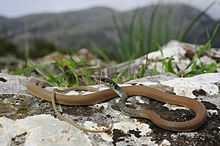 |
| Telescopus fallax |
European cat snake |
The species is found in the southern Struma valley and the Eastern Rhodope Mountains.[67] |
LC [68] |
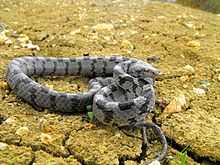 |
| Zamenis longissimus |
Aesculapian snake |
The species is found in the whole country, up to 1600 m altitude, rarely recorded up to 2000 m in Belasitsa.[69] |
LC [70] |
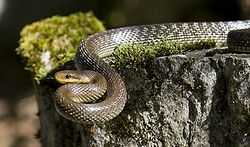 |
| Zamenis situla |
European ratsnake |
The species is found in the southern Struma valley, the foothills of the Western Rhodope Mountains and the southern Black Sea coast.[71] |
LC [72] |
 |
|
Typhlopidae
| Species |
Common name |
Distribution |
Status |
Image |
| Typhlops vermicularis |
European blind snake |
The species is found in southern Bulgaria: lower Struma valley, Eastern Rhodope Mountains, Dervent Heights, Strandzha, the southern Black Sea coast.[73] |
NE [74] |
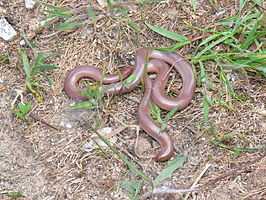 |
|
Viperidae
| Species |
Common name |
Distribution |
Status |
Image |
| Vipera ammodytes |
horned viper |
The species is found in the whole country, up to 1450 m altitude.[75] |
LC [76] |
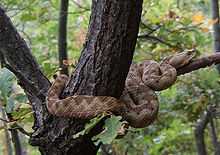 |
| Vipera aspis |
aspic viper |
Only two specimens have been recorded in Bulgaria — one found near Harmanli in 1933, the other in unknown location in the beginning of the 20th century.[77] |
LC [78] |
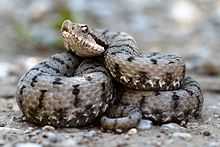 |
| Vipera berus |
common European adder |
The species is found in the mountains, at an altitude of 1000—2700 m — Rila, Pirin, Vistosha, western Rhodope Mountains, western and central Balkan Mountains, central Sredna Gora and Osogovo.[79] |
LC [80] |
 |
| Vipera ursinii |
meadow viper |
The species is known only from a few specimen found in the Shumen Plateau and Lyulin Mountain. There are no records since 1934.[81] |
VU [82] |
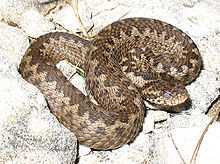 |
|
See also
Footnotes
Notes
^ a: Conservation status at a world level (not exclusive to Bulgaria) of the species according to the IUCN Red List:
Conservation status - IUCN Red List of Threatened Species:
- EX - Extinct, EW - Extinct in the wild
- CR - Critically endangered, EN - Endangered, VU - Vulnerable
- NT - Near threatened, LC - Least concern
- DD - Data deficient, NE - Not evaluated
Citations
- ↑ Biserkov 2007, p. 34
- ↑ "Cheloniidae". Animal Diversity Web. Retrieved 25 March 2015.
- ↑ Biserkov 2007, p. 75
- ↑ Arntzen, J.W. et al. (2009). Caretta caretta. In: IUCN 2008. IUCN Red List of Threatened Species. Retrieved 18 March 2015.
- ↑ Biserkov 2007, p. 76
- ↑ Arntzen, J.W. et al. (2009). Chelonia mydas. In: IUCN 2008. IUCN Red List of Threatened Species. Retrieved 18 March 2015.
- ↑ Rhodin 2010, pp. 000.99-000.107
- ↑ Biserkov 2007, p. 70
- ↑ Arntzen, J.W. et al. (2009). Emys orbicularis. In: IUCN 2008. IUCN Red List of Threatened Species. Retrieved 18 March 2015.
- ↑ Rhodin 2010, p. 000.91
- ↑ Biserkov 2007, p. 73
- ↑ "Mauremys rivulata". The Reptile Database. Retrieved 18 March 2015.
- ↑ "Testudinidae". Animal Diversity Web. Retrieved 25 March 2015.
- ↑ Biserkov 2007, p. 68
- ↑ Arntzen, J.W. et al. (2009). Testudo graeca. In: IUCN 2008. IUCN Red List of Threatened Species. Retrieved 18 March 2015.
- ↑ Biserkov 2007, p. 67
- ↑ Arntzen, J.W. et al. (2009). Testudo hermanni. In: IUCN 2008. IUCN Red List of Threatened Species. Retrieved 18 March 2015.
- ↑ "Anguidae". Animal Diversity Web. Retrieved 25 March 2015.
- ↑ "Anguidae". The Reptile Database. Retrieved 25 March 2015.
- ↑ Biserkov 2007, p. 89
- ↑ "Anguis fragilis". The Reptile Database. Retrieved 18 March 2015.
- ↑ Biserkov 2007, p. 90
- ↑ "Pseudopus apodus". The Reptile Database. Retrieved 18 March 2015.
- ↑ "Gekkonidae". The Reptile Database. Retrieved 25 March 2015.
- ↑ Biserkov 2007, p. 70
- ↑ Arntzen, J.W. et al. (2009). Cyrtopodion kotschyi. In: IUCN 2008. IUCN Red List of Threatened Species. Retrieved 18 March 2015.
- ↑ Biserkov 2007, p. 91
- ↑ Arntzen, J.W. et al. (2009). Darevskia praticola. In: IUCN 2008. IUCN Red List of Threatened Species. Retrieved 18 March 2015.
- ↑ Biserkov 2007, p. 93
- ↑ Arntzen, J.W. et al. (2009). Lacerta agilis. In: IUCN 2008. IUCN Red List of Threatened Species. Retrieved 18 March 2015.
- ↑ Biserkov 2007, p. 95
- ↑ Arntzen, J.W. et al. (2009). Lacerta trilineata. In: IUCN 2008. IUCN Red List of Threatened Species. Retrieved 18 March 2015.
- ↑ Biserkov 2007, p. 96
- ↑ Arntzen, J.W. et al. (2009). Lacerta viridis. In: IUCN 2008. IUCN Red List of Threatened Species. Retrieved 18 March 2015.
- ↑ Biserkov 2007, p. 97
- ↑ "Ophisops elegans". The Reptile Database. Retrieved 18 March 2015.
- ↑ Biserkov 2007, p. 99
- ↑ Arntzen, J.W. et al. (2009). Podarcis erhardii. In: IUCN 2008. IUCN Red List of Threatened Species. Retrieved 18 March 2015.
- ↑ Biserkov 2007, p. 101
- ↑ Arntzen, J.W. et al. (2009). Podarcis muralis. In: IUCN 2008. IUCN Red List of Threatened Species. Retrieved 18 March 2015.
- ↑ Biserkov 2007, p. 102
- ↑ Arntzen, J.W. et al. (2009). Podarcis tauricus. In: IUCN 2008. IUCN Red List of Threatened Species. Retrieved 18 March 2015.
- ↑ Biserkov 2007, p. 103
- ↑ Arntzen, J.W. et al. (2009). Zootoca vivipara. In: IUCN 2008. IUCN Red List of Threatened Species. Retrieved 18 March 2015.
- ↑ Biserkov 2007, p. 87
- ↑ Arntzen, J.W. et al. (2009). Ablepharus kitaibelii. In: IUCN 2008. IUCN Red List of Threatened Species. Retrieved 18 March 2015.
- ↑ Biserkov 2007, p. 111
- ↑ "Eryx jaculus". The Reptile Database. Retrieved 18 March 2015.
- ↑ Biserkov 2007, p. 124
- ↑ "Coronella austriaca". The Reptile Database. Retrieved 18 March 2015.
- ↑ Biserkov 2007, p. 115
- ↑ "Dolichophis caspius". The Reptile Database. Retrieved 18 March 2015.
- ↑ Biserkov 2007, p. 121
- ↑ "Elaphe quatuorlineata". The Reptile Database. Retrieved 18 March 2015.
- ↑ Biserkov 2007, p. 122
- ↑ "Elaphe sauromates". The Reptile Database. Retrieved 18 March 2015.
- ↑ Biserkov 2007, p. 127
- ↑ Arntzen, J.W. et al. (2009). Malpolon monspessulanus. In: IUCN 2008. IUCN Red List of Threatened Species. Retrieved 18 March 2015.
- ↑ Biserkov 2007, p. 125
- ↑ Arntzen, J.W. et al. (2009). Natrix natrix. In: IUCN 2008. IUCN Red List of Threatened Species. Retrieved 18 March 2015.
- ↑ Biserkov 2007, p. 126
- ↑ Arntzen, J.W. et al. (2009). Natrix tessellata. In: IUCN 2008. IUCN Red List of Threatened Species. Retrieved 18 March 2015.
- ↑ Biserkov 2007, p. 117
- ↑ Arntzen, J.W. et al. (2009). Platyceps collaris. In: IUCN 2008. IUCN Red List of Threatened Species. Retrieved 18 March 2015.
- ↑ Biserkov 2007, p. 116
- ↑ Arntzen, J.W. et al. (2009). Platyceps najadum. In: IUCN 2008. IUCN Red List of Threatened Species. Retrieved 18 March 2015.
- ↑ Biserkov 2007, p. 128
- ↑ Arntzen, J.W. et al. (2009). Telescopus fallax. In: IUCN 2008. IUCN Red List of Threatened Species. Retrieved 18 March 2015.
- ↑ Biserkov 2007, p. 119
- ↑ Arntzen, J.W. et al. (2009). Zamenis longissimus. In: IUCN 2008. IUCN Red List of Threatened Species. Retrieved 18 March 2015.
- ↑ Biserkov 2007, p. 120
- ↑ Arntzen, J.W. et al. (2009). Zamenis situla. In: IUCN 2008. IUCN Red List of Threatened Species. Retrieved 18 March 2015.
- ↑ Biserkov 2007, p. 109
- ↑ "Typhlops vermicularis". The Reptile Database. Retrieved 18 March 2015.
- ↑ Biserkov 2007, p. 131
- ↑ Arntzen, J.W. et al. (2009). Vipera ammodytes. In: IUCN 2008. IUCN Red List of Threatened Species. Retrieved 18 March 2015.
- ↑ Biserkov 2007, p. 135
- ↑ Arntzen, J.W. et al. (2009). Vipera aspis. In: IUCN 2008. IUCN Red List of Threatened Species. Retrieved 18 March 2015.
- ↑ Biserkov 2007, p. 133
- ↑ Arntzen, J.W. et al. (2009). Vipera berus. In: IUCN 2008. IUCN Red List of Threatened Species. Retrieved 18 March 2015.
- ↑ Biserkov 2007, p. 134
- ↑ Arntzen, J.W. et al. (2009). Vipera ursinii. In: IUCN 2008. IUCN Red List of Threatened Species. Retrieved 18 March 2015.
References
Sources
- Бисерков, В. (V. Biserkov) (2007). Определител на земноводните и влечугите в България (A Field Guide to Amphibians and Reptiles of Bulgaria) (in Bulgarian). София (Sofia): Зелени Балкани (Green Balkans). ISBN 978-954-9433-07-4.
- Бешков, Владимир (Vladimir Beshkov); Кръстьо Нанев (Krastyo Nanev) (2002). Земноводни и влечуги в България (Amphibians and Reptiles of Bulgaria) (in Bulgarian). София (Sofia): Пенсофт (Pensoft). ISBN 954-642-147-2.
External links
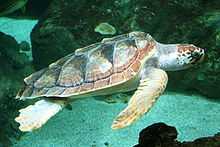
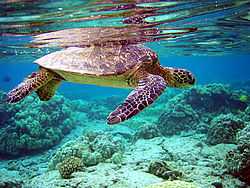


















.jpg)










